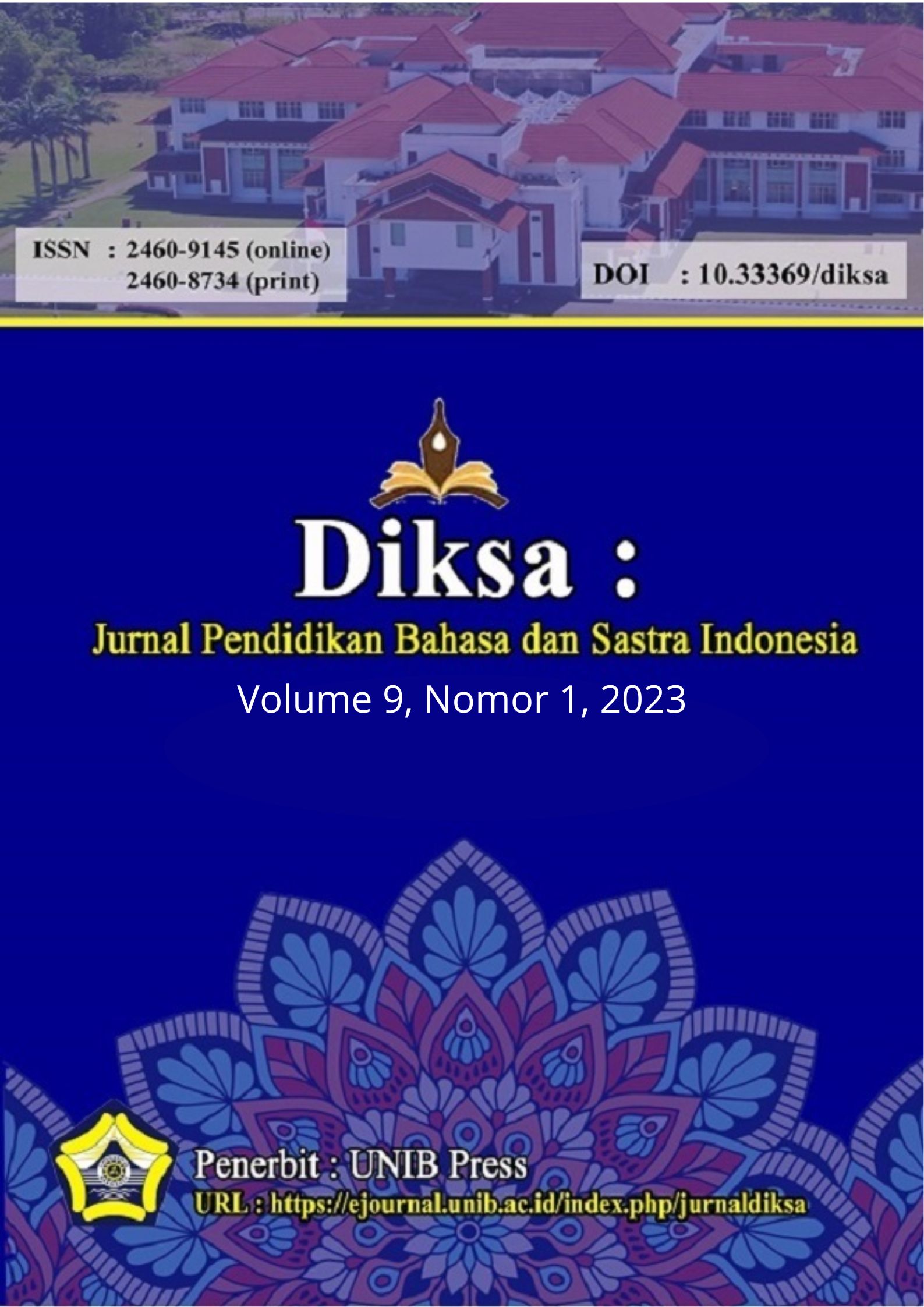Main Article Content
Abstract
The 2013 Curriculum of Indonesia mandates various concepts that must be applied through policies and practices by the related parties. Some of them are the implementation of scientific approach and HOTS-based evaluation in the teaching and learning process. The aims of this research are (1) to describe the form of daily Indonesian language HOTS-based test questions; (2) to describe the results of students' creative thinking abilities; (3) to describe the level of difficulty of the daily Indonesian language HOTS-based test questions. This study employed a descriptive method with qualitative analysis techniques. The population of this study was 30 students of class XI IPA SMA Muhammadiyah Cibiuk Garut, while the sample was 20 students who were selected by random sampling technique. The data collection technique was carried out with documentation techniques by analyzing both the test items and the answers. The results show: (1) the daily Indonesian language test items are not completely HOTS-based. (2) not all of the test items meet the creative thinking indicators. (3) there are test items that are not suitable with the difficulty level. In the test items of making proposal chapter, out of five questions, two of them were considered too easy, because of that the questions were not suitable to use in HOTS-based test. From the results of the research above, the implementation of HOTS in test requires a lot of efforts from both the teachers and students. Even though the created test items have been considered at the HOTS level, if they do not assist the students in thinking creatively, then the questions cannot be considered to be able to encourage creative thinking process.
Keywords
Article Details
Copyright (c) 2023 lina siti nurwahidah

This work is licensed under a Creative Commons Attribution-ShareAlike 4.0 International License.
Authors who publish with this journal agree to the following terms:
- Authors retain copyright and grant the journal right of first publication with the work simultaneously licensed under a Creative Commons Attribution License that allows others to share the work with an acknowledgment of the work's authorship and initial publication in this journal.
- Authors are able to enter into separate, additional contractual arrangements for the non-exclusive distribution of the journal's published version of the work (e.g., post it to an institutional repository or publish it in a book), with an acknowledgment of its initial publication in this journal.
- Authors are permitted and encouraged to post their work online (e.g., in institutional repositories or on their website) prior to and during the submission process, as it can lead to productive exchanges, as well as earlier and greater citation of published work (See The Effect of Open Access).
References
- Farichatun. 2015. Analisis Data dalam Penelitian Kualitatif. [On Line]. https://www.kompasiana.com/farichatun/556b6d1f2ab0bd174de40eed/analisis-data-dalam-penelitian-kualitatif. [7 April 2020]
- Huda. 2016. Jenis- Jenis Keterampilan Berpikir. [On line] http://www.bangsaku.web.id/2016/01/ beberapa- jenis-keterampilan-berpikir.html. [03 November 2019]
- Herdi. 2010. Kemampuan Berpikir Kreatif Siswa. [On line]. https://herdy07.wordpress.com/2010/05/27/kemampuan-berfikir-kreatif-siswa/. [ 18 Maret 2020]
- Nugroho. 2018. High Order Thinking Skills. Jakarta. PT Gramedia Widia Sarana Indonesia.
- Nurgiantoro. 2016. Penilaian Pembelajaran Bahasa Berbasis Kompetensi. Yogyakarta. BPFE-Yogyakarta.
- Putra. 2016. Kemampuan Berpikir Kreatif. [On line] http://brianstechno.blogspot.com/2016/11/definisi-berpikir-kreatif.html. [ 12 Maret 2020]
- Sugiono. 2011. Metode Penelitian Pendidikan. Bandung. Alfabeta
- Setiawati at. al (2019) Buku Penilaian Berorientasi Higher Order Thingking Skills. Jakarta. Direktorat Jenderal Guru dan Tenaga Kependidikan Kementrian Pendidikan dan Kebudayaan 2019.
References
Farichatun. 2015. Analisis Data dalam Penelitian Kualitatif. [On Line]. https://www.kompasiana.com/farichatun/556b6d1f2ab0bd174de40eed/analisis-data-dalam-penelitian-kualitatif. [7 April 2020]
Huda. 2016. Jenis- Jenis Keterampilan Berpikir. [On line] http://www.bangsaku.web.id/2016/01/ beberapa- jenis-keterampilan-berpikir.html. [03 November 2019]
Herdi. 2010. Kemampuan Berpikir Kreatif Siswa. [On line]. https://herdy07.wordpress.com/2010/05/27/kemampuan-berfikir-kreatif-siswa/. [ 18 Maret 2020]
Nugroho. 2018. High Order Thinking Skills. Jakarta. PT Gramedia Widia Sarana Indonesia.
Nurgiantoro. 2016. Penilaian Pembelajaran Bahasa Berbasis Kompetensi. Yogyakarta. BPFE-Yogyakarta.
Putra. 2016. Kemampuan Berpikir Kreatif. [On line] http://brianstechno.blogspot.com/2016/11/definisi-berpikir-kreatif.html. [ 12 Maret 2020]
Sugiono. 2011. Metode Penelitian Pendidikan. Bandung. Alfabeta
Setiawati at. al (2019) Buku Penilaian Berorientasi Higher Order Thingking Skills. Jakarta. Direktorat Jenderal Guru dan Tenaga Kependidikan Kementrian Pendidikan dan Kebudayaan 2019.
